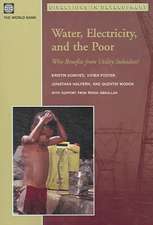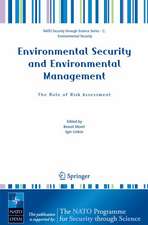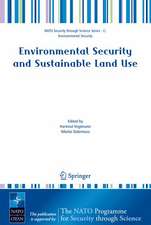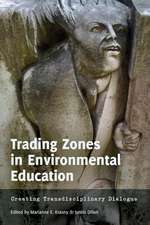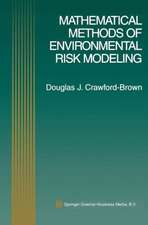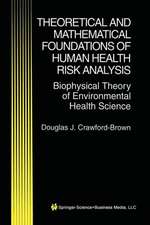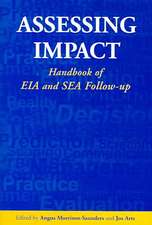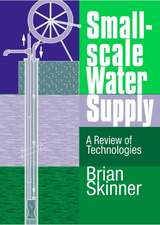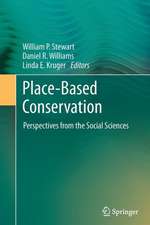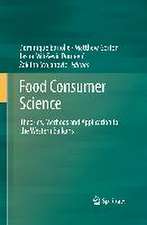Risk-Based Environmental Decisions: Methods and Culture
Autor Douglas J. Crawford-Brownen Limba Engleză Paperback – 22 mar 2013
An important feature of Risk-Based Environmental Decision: Methods and Culture is that it is designed around a series of detailed case studies of environmental risk analysis which walk the reader from the historical nature of the problem, to the formulation as a risk-based problem, to the conduct of risk analysis, and on to the application, debate, and defense of the risk analysis.
| Toate formatele și edițiile | Preț | Express |
|---|---|---|
| Paperback (1) | 637.59 lei 43-57 zile | |
| Springer Us – 22 mar 2013 | 637.59 lei 43-57 zile | |
| Hardback (1) | 644.30 lei 43-57 zile | |
| Springer Us – 31 oct 1999 | 644.30 lei 43-57 zile |
Preț: 637.59 lei
Preț vechi: 750.11 lei
-15% Nou
Puncte Express: 956
Preț estimativ în valută:
122.04€ • 132.61$ • 102.58£
122.04€ • 132.61$ • 102.58£
Carte tipărită la comandă
Livrare economică 21 aprilie-05 mai
Preluare comenzi: 021 569.72.76
Specificații
ISBN-13: 9781461373827
ISBN-10: 1461373824
Pagini: 240
Ilustrații: XII, 224 p.
Dimensiuni: 155 x 235 x 13 mm
Greutate: 0.34 kg
Ediția:Softcover reprint of the original 1st ed. 1999
Editura: Springer Us
Colecția Springer
Locul publicării:New York, NY, United States
ISBN-10: 1461373824
Pagini: 240
Ilustrații: XII, 224 p.
Dimensiuni: 155 x 235 x 13 mm
Greutate: 0.34 kg
Ediția:Softcover reprint of the original 1st ed. 1999
Editura: Springer Us
Colecția Springer
Locul publicării:New York, NY, United States
Public țintă
ResearchCuprins
1. Risk, Rationality and Decisions.- 1.1. Analysis of Risk.- 1.2. Conceptions of Risk.- 1.3. Rationality and Risk.- 1.4. Rationality and Logic Trees.- 1.5. The Uses of Risk Analysis.- 1.6. Risk, Values and Culture.- 2. The Structure of Environmental Risk Assessments.- 2.1. Formulating the Problem.- 2.2. Hazard Identification.- 2.3. Risk Characterization.- 2.4. Risk Communication.- 3. Assessing Exposure.- 3.1. Emerging Pathogens.- 3.2. Identifying Sources and Characterizing Strength.- 3.3. Dispersion and Fate.- 3.4. Dispersion Coefficients and Equilibrium Ratios.- 3.5. Areal-weighted, Time-weighted and Population-weighted Averages.- 3.6. Exposure Pathways.- 3.7. ADRI and MIR.- 3.8. Data and Models.- 3.9. Summarizing Exposure.- 4. Exposure-Response Assessment.- 4.1. Environmental Radon.- 4.2. Pharmacokinetics.- 4.3. Pharmacodynamics and Dose-Response.- 4.4. Missing Steps.- 4.5. Human Equivalent Concentrations.- 4.6. Intersubject Variability.- 4.7. The Social Construction of the Causes of Risk Variation.- 5. Regulatory Science: Risk and Decisions.- 5.1. Decisions and the Precautionary Principle.- 5.2. NOELs, NOAELs, LOELs and LOAELs.- 5.3. RfDs and RfCs.- 5.4. Benchmark Doses.- 5.5. Hazard Quotients and Hazard Indices.- 5.6. Linear Carcinogens.- 5.7. Nonlinear Carcinogens.- 5.8. Exposure Limits and Ample Margin of Safety.- 5.9. Risk, Science and the Courts.- 6. Uncertainty and Variability Analysis.- 6.1. Protecting Against Risk.- 6.2. Principles of Uncertainty for Discrete Options.- 6.3. Uncertainty for Continuous Variables.- 6.4. EPA Guidelines on Monte Carlo Analysis.- 6.5. Sensitivity Analysis.- 6.6. Variability Analysis.- 6.7. Nested Analyses.- 6.8. Risk-Based Decision Under Variability and Uncertainty.- 7. Risk, Systems Analysis and Optimization.- 7.1. Risk ManagementOptions.- 7.2. A Decision Problem.- 7.3. Optimization Principles.- 7.4. Applying the Lessons.- 7.5. Closing Comments.





